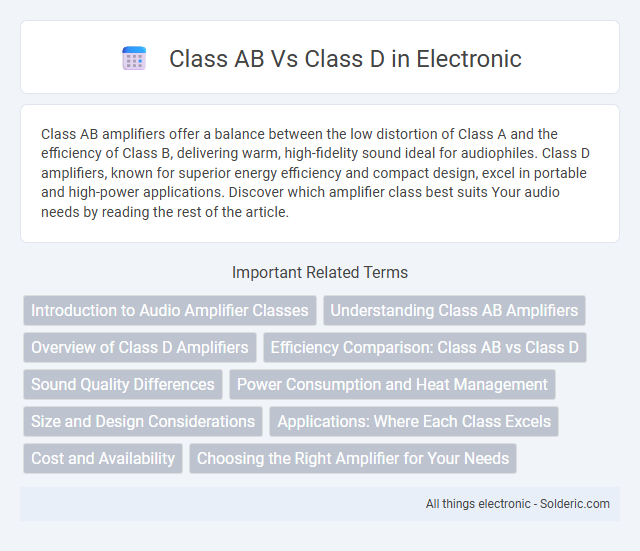Class AB amplifiers offer a balance between the low distortion of Class A and the efficiency of Class B, delivering warm, high-fidelity sound ideal for audiophiles. Class D amplifiers, known for superior energy efficiency and compact design, excel in portable and high-power applications. Discover which amplifier class best suits Your audio needs by reading the rest of the article.
Comparison Table
| Feature | Class AB Amplifier | Class D Amplifier |
|---|---|---|
| Operation | Analog linear operation | Digital switching operation |
| Efficiency | 50-70% | 80-95% |
| Heat Generation | Moderate heat, requires heat sinks | Low heat, smaller heat sinks |
| Sound Quality | High fidelity, low distortion | Good, some high-frequency noise |
| Size and Weight | Larger and heavier | Compact and lightweight |
| Cost | Moderate cost | Generally lower cost |
| Applications | Hi-Fi audio, guitar amps | Portable devices, car audio |
Introduction to Audio Amplifier Classes
Class AB amplifiers combine the efficiency of Class B with the low distortion of Class A, making them popular for high-fidelity audio applications. Class D amplifiers use pulse-width modulation to achieve higher efficiency and generate less heat, ideal for portable and compact audio devices. Both classes serve distinct roles in audio amplification, balancing sound quality and power efficiency.
Understanding Class AB Amplifiers
Class AB amplifiers combine the low distortion of Class A with the higher efficiency of Class B, operating with a bias current that keeps both transistors slightly active to reduce crossover distortion. They typically achieve efficiency levels around 50-70%, making them suitable for high-fidelity audio applications where sound quality is prioritized. Their linear amplification and moderate power consumption provide a balanced solution for home audio systems, musical instrument amplifiers, and professional sound equipment.
Overview of Class D Amplifiers
Class D amplifiers operate using a pulse-width modulation (PWM) technique that switches transistors fully on and off to maximize efficiency, often reaching over 90%. Unlike Class AB amplifiers, which use linear operation and suffer from higher power losses and heat dissipation, Class D amplifiers produce less heat and allow for more compact, lightweight designs. These characteristics make Class D amplifiers highly suitable for portable audio devices, subwoofers, and applications requiring energy efficiency and minimal thermal management.
Efficiency Comparison: Class AB vs Class D
Class D amplifiers offer significantly higher efficiency, typically ranging from 80% to 95%, compared to Class AB amplifiers, which usually operate around 50% to 70% efficiency due to their linear output stage design. This increased efficiency in Class D results from their switching operation, minimizing power loss and heat generation. Consequently, Class D amplifiers are preferred for portable and high-power applications where energy conservation and thermal management are critical.
Sound Quality Differences
Class AB amplifiers deliver superior sound quality with lower distortion and smoother audio reproduction, making them ideal for audiophiles seeking clarity and warmth in their music. Class D amplifiers, while highly efficient and compact, may introduce slight distortion and noise artifacts, potentially affecting the purity of your audio experience. Choosing between Class AB and Class D depends on whether your priority is impeccable sound fidelity or energy-efficient performance.
Power Consumption and Heat Management
Class AB amplifiers exhibit higher power consumption due to continuous biasing of output transistors, resulting in substantial heat generation that often requires robust heat sinks for effective thermal management. In contrast, Class D amplifiers operate with high efficiency, converting power more effectively by using pulse-width modulation and switching output devices, which drastically reduces heat production and minimizes the need for extensive cooling solutions. This efficiency advantage makes Class D amplifiers preferable in applications where low power consumption and compact heat management are critical.
Size and Design Considerations
Class AB amplifiers typically have larger sizes and more complex heat dissipation designs because of their analog circuitry and continuous output stage operation. Class D amplifiers feature compact designs and smaller footprints due to their high-efficiency switching operation, which generates less heat and requires smaller heat sinks. Designers often prefer Class D for space-constrained applications and Class AB when audio fidelity and linearity take precedence over size.
Applications: Where Each Class Excels
Class AB amplifiers excel in high-fidelity audio applications such as home theater systems and professional audio equipment due to their balance of sound quality and efficiency. Class D amplifiers are ideal for portable and battery-powered devices, including Bluetooth speakers and subwoofers, because of their superior energy efficiency and compact size. Automotive audio systems often leverage Class D amplifiers to maximize power output while minimizing heat dissipation.
Cost and Availability
Class AB amplifiers generally have moderate cost and widespread availability, making them a popular choice for mid-range audio equipment due to their balance of efficiency and sound quality. Class D amplifiers tend to be more cost-effective for high-power applications and are increasingly available as advancements in technology reduce their previous limitations in audio fidelity. Market trends show a growing preference for Class D amplifiers in portable and battery-powered devices due to their superior efficiency and compact design.
Choosing the Right Amplifier for Your Needs
Class AB amplifiers deliver a balanced combination of efficiency and sound quality, making them ideal for audiophiles seeking warm, high-fidelity audio with moderate power consumption. Class D amplifiers excel in energy efficiency and compact design, providing powerful output suitable for portable and space-constrained applications. Selecting the right amplifier depends on your priorities: prioritize Class AB for superior audio precision or choose Class D for efficient, high-power performance in compact systems.
Class AB vs Class D Infographic

 solderic.com
solderic.com